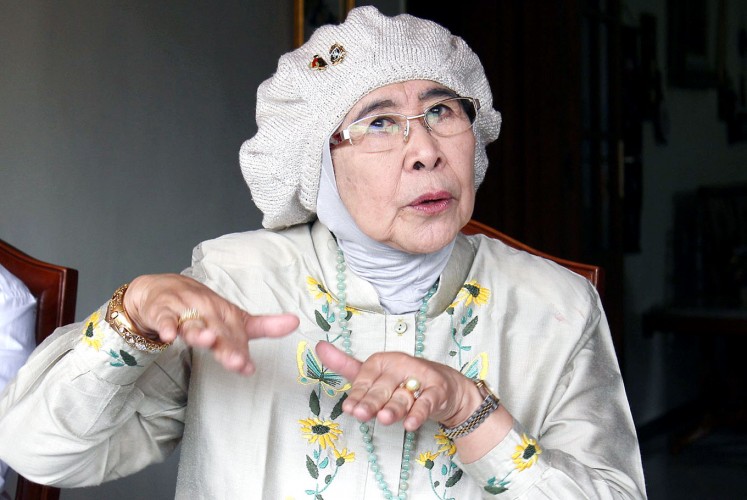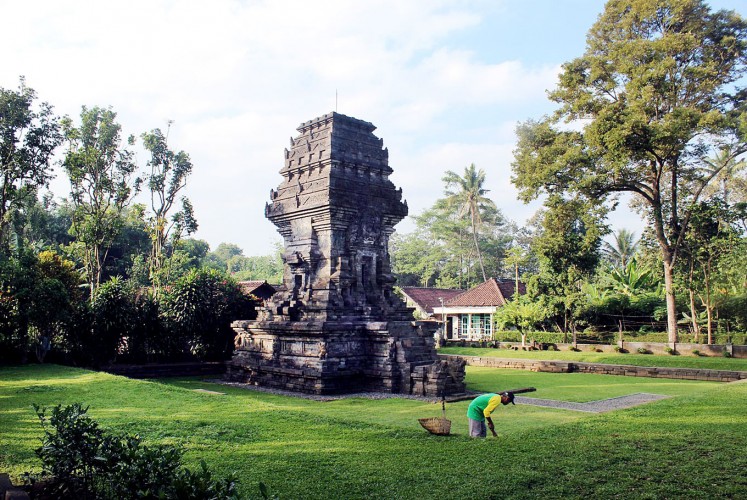Portraits of powerful women
Art in Indonesia is largely men’s business.
Change Size
 Strong women: Eka Mulya Astuti poses in front of her work, a triptych of Pramodhawardhani (JP/Erlinawati Graham)
Strong women: Eka Mulya Astuti poses in front of her work, a triptych of Pramodhawardhani (JP/Erlinawati Graham)
W
hen Eka Mulya Astuti was in high school, her class had an exercise in drawing. The teenager loved art so she anticipated praise, but instead, she was accused of plagiarism because her work was far superior to her peers’ efforts.
“I was so angry,” Astuti recalled, “I was also ashamed; I threw it away.
“In those days students didn’t argue. When I had the chance to select courses I chose natural science, which didn’t include art, just to avoid that woman,” she said of the teacher.
Eka said she was 15 back then, but now at 48, she still remembers that moment clearly. “Eventually I became a teacher so I took great care when criticising students’ work; I understand the need for positive reinforcement,” she said.
Eka quit school and shook off the damning response of a miserly mistress to triumph in her first calling. She’s also discovered another hurdle — being taken seriously. Art in Indonesia is largely men’s business.

Bandung mixed-media artist and gallery owner Moel Soenarko, 77, reckons creative Indonesian women have a greater struggle than men in getting their work appreciated.
On a recent visit to Malang the veteran campaigner for equality held a soiree where she advised Eka and other female artists to go beyond selling their works privately and mount formal exhibitions.
“We have to get out in the public,” she said. “Why do so many people who don’t do anything get in the media while we women are ignored? We need to express ourselves and get noticed.”
Eka’s portraiture is now being commissioned by collectors like Jim Willey, an American executive at the Paiton power station complex in East Java. His Las Vegas home is adorned with art from Cambodia, Nepal, China, Thailand, India and Indonesia.
Willey describes Eka’s work as “unique, and totally cool.” Each painting includes a narrative (in Javanese) that specifically describes the subject in the painting, which is rare.
“Visitors do not often understand who is on the wall. Appreciation is enhanced because the viewer can put the subject in historical perspective. Eka provides a connection to her art,” he said.
Eka is obsessed with ancient Javanese history and mythology, particularly stories of strong women; this is no surprise as her mother Mariana raised her alone from the age of two when her father died. She has also been a single mom for the past decade.

Her luminaries include Ken Dedes, the consort of Ken Arok, the first ruler of the Shiva-Buddha kingdom of Singhasari. She is also intrigued by Calonarang — a completely different figure.
According to folklore, Calonarang was a widow possessing powerful black magic who lived in Girah, a village near Kediri in East Java a millennium ago. She allegedly caused pestilence because no man would marry her daughter Ratna Manggali. The plague was lifted only when Calonarang’s spellbook was stolen.
The wicked-witch genre also features in medieval European mythology as an eccentric crone or a threat to marriages — certainly a handy scapegoat. She is cursed when crops fail or babies die. However, feminist Indonesian poet Toeti Heraty Noerhadi-Roosseno has another interpretation: She sees Calonarang as a woman victimized by a patriarchal repressive society.
Eka has completed one large portrait of Calonarang, which she won’t sell, and is planning others. She is working on a triptych of Pramodhawardhani, the ninth-century queen credited with initiating Borobudur, the world’s largest Buddhist temple.
Because no portraits exist of her subjects, Eka reincarnates them in a semi-abstract style using acrylics. Among her heroines is the late Mexican artist Frida Kahlo who also specialised in striking portraits of women.
“To get inspiration I meditate, burn incense and play gamelan music. It’s difficult to concentrate because friends drop in for long chats; they don’t think an artist at home is a worker.
“Once I was asked to paint Nyai Loro Kidul, but felt uneasy about the assignment,” she said.
In Javanese mythology, Nyai Loro Kidul is the queen of the Southern Sea famous for having shape-shifting abilities, and is said to drown seafarers who wear green.
“When the canvas arrived it was mouldy, though the supplier said it was clean and fresh when sent. I saw this as an omen so haven’t done the picture,” Eka said.
Eka’s father was an artist but died when she was young. Mariana raised their child alone by making and selling food. Eka’s talents went beyond art; she won a university scholarship to study English, has written 18 English texts and worked as an interpreter for international companies.

Eka belongs to Bol Brutu, which started in 2009 when a group of artists visited the Kyai Sadrach historical site in Purworejo, Central Java. The name is an acronym from Gerombolan Pemburu Batu, which translates awkwardly as the Horde Hunters Group. It stages exhibitions and publishes art texts.
Closer to her Malang home is the Hindu Kidal Temple, her source of insights and spiritual connections. The temple was completed in 1260 as a shrine to King Anushapati, son of Ken Dedes.
A Shiva statue believed to be from the Kidal Temple is in Leiden’s National Museum of Ethnology. Surprisingly, Eka is not advocating its return.
“I want Indonesians to appreciate our history and I hope my art helps. But Kidal is no longer the ideal environment. The statue is probably safer, getting better care and being seen by more people where it is,” she said.
Just after this interview, an allegedly deranged doctor smashed his car through the gates and crashed into the temple causing minor damage. He was unhurt.









